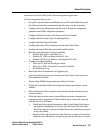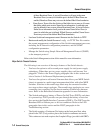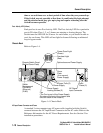
1-4 General Description
GigWorks MKII-16 Switch Model MKII-BASE16
59003-01 Rev. A Installer's/User's Manual
General Description
of these Broadcast Zones. A port will broadcast to all ports in the same
Broadcast Zone (or zones) in-which the port is defined. If Hard Zones are
enabled, Broadcast Zones may not cross the defined Hard Zone boundaries.
• Name Server Zones allow the division of the fabric into as many as 16 zones
that define which ports receive Name Server information. A particular port
may be defined in one or more of these Broadcast Zones. A port will receive
Name Server information for all ports in the same Name Server Zone (or
zones) in-which the port is defined. If Hard Zones are enabled, Name Server
Zones may not cross the defined Hard Zone boundaries.
• Load new Switch and management control firmware into the Switch via TFTP
• Retrieve and modify the Switch file named config via TFTP. This file contains
the current management configuration of the Switch management processes,
including the IP network configuration parameters, and the SNMP
configuration parameters.
• Manage the Switch using Simple Network Management Protocol (SNMP)
as the transport protocol
Refer to the Switch Management section of this manual for more information.
Major Switch Chassis Features
The following is an overview of the major features of the Switch chassis:
• You have the option to add a second power supply for total power supply
redundancy. When there are two power supplies, they each become “hot
pluggable”. Refer to the Power Supply paragraphs later in this section and
also to Section 4 for Removal Replacement procedures.
• You have the option to add control firmware that allows your MKII Switch
chassis to operate in a multi-stage interconnection fabric with other MKII
Switches. Switches in this multi-stage fabric may be connected in either
two-stage or three-stage topologies. These multi-stage topologies use cross-
connecting (not cascading) for the fewest number of fabric hops between
users. Refer to the Reference Information appendix for more information.
• The Switch undergoes a battery of Power-On-Self-Tests (POSTs) each time
it is powered-up. POST provides one pass through the battery of tests but
does not test the GigaBit Interface Converters (GBICs). The POST uses the
Heartbeat LED to indicate pass or fail test conditions. Refer to the LED
paragraphs later in this section and the POST paragraphs in the
Troubleshooting section.
• The Switch contains a Continuous Test button on the front panel that, when
placed in the TST (Test) position, places the Switch in continuous test mode.
This continuous test mode requires that Loopback Plugs (provided with GBICs


















